A comprehensive guide to understanding how far each golf club travels, helping golfers optimize their game by considering swing speed, ball speed, and smash factor for precise distance control.
Why Understanding Golf Club Distances is Crucial for Improving Your Game
Understanding golf club distances is essential for improving your game, as it helps golfers make informed decisions on the course. Knowing how far each club travels allows for precise shot selection, reducing errors and improving scoring. Factors like swing speed, ball speed, and smash factor significantly influence distance, making it vital to tailor strategies to individual capabilities. Accurate distance control enables better gapping between clubs, ensuring consistent performance. Additionally, environmental factors like terrain and wind must be considered to adjust club choices effectively. By mastering club distances, golfers can enhance their overall consistency, lower scores, and gain a competitive edge. This knowledge is foundational for refining techniques and adapting to various playing conditions.

Factors Influencing Golf Club Distances
Swing speed, ball speed, smash factor, and strike quality are key factors affecting how far a golf ball travels, shaping the distance each club achieves consistently.
The Role of Swing Speed in Determining Club Distance
Swing speed is a critical factor in determining how far a golf ball travels. A faster swing speed generally results in greater distance, as it generates more energy transfer to the ball. However, swing speed alone doesn’t guarantee maximum distance; efficiency in the swing and ball-strike quality also play significant roles. Golfers with higher swing speeds can optimize their club selection to maximize distance potential. Understanding personal swing speed helps in choosing the right clubs and adjusting techniques for consistent performance. Accurate measurement and testing are essential to determine individual swing speed and its impact on overall distance.
Ball Speed and Its Impact on How Far You Hit the Ball
Ball speed is a crucial determinant of distance in golf, often exceeding swing speed in importance. It measures how fast the ball leaves the clubface after impact. Higher ball speeds result in longer shots, assuming optimal launch conditions. Factors influencing ball speed include clubhead speed, strike quality, and equipment specs. A well-struck shot with a high ball speed will travel farther than a slower-speed shot with improper contact. Launch monitors can track ball speed, helping golfers identify areas for improvement. Maximizing ball speed through technique adjustments and proper equipment fitting can significantly enhance distance and overall performance on the course.
Smash Factor: Maximizing Efficiency for Longer Shots
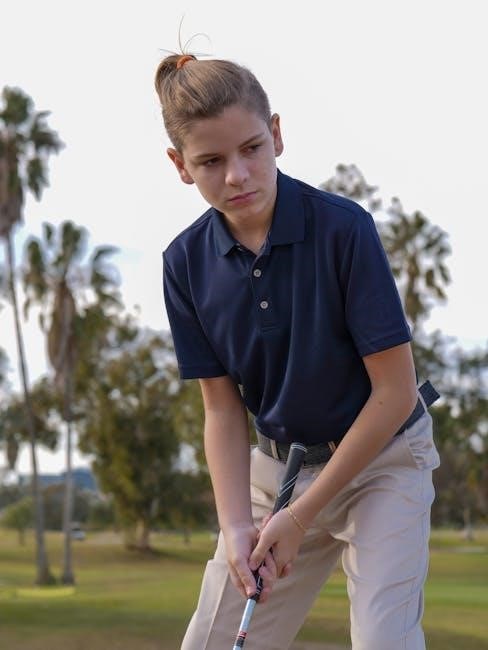
Smash factor, the ratio of ball speed to clubhead speed, is key to efficiency in golf. A higher smash factor means more energy is transferred to the ball, leading to greater distance. It’s particularly important in drives and fairway shots. Factors like clubfitting and swing mechanics influence smash factor. Proper adjustments can optimize energy transfer, resulting in longer, more consistent shots. Using technology like launch monitors helps track and improve smash factor, ensuring maximum efficiency with each swing, thus enhancing overall performance and distance on the course.
Quality of Ball Striking and Its Effect on Distance
The quality of ball striking significantly impacts how far the ball travels. A clean strike maximizes energy transfer, resulting in greater distance, while poor contact reduces efficiency. Ball position, swing path, and clubface alignment are critical factors. Mis-hits, such as thin or fat shots, lead to distance loss. Consistent, centered strikes are essential for optimal performance. Regular practice and equipment adjustments can improve strike quality, ensuring better distance control and accuracy. Monitoring ball flight and using training aids can help identify and correct issues, leading to more consistent and longer shots on the course.
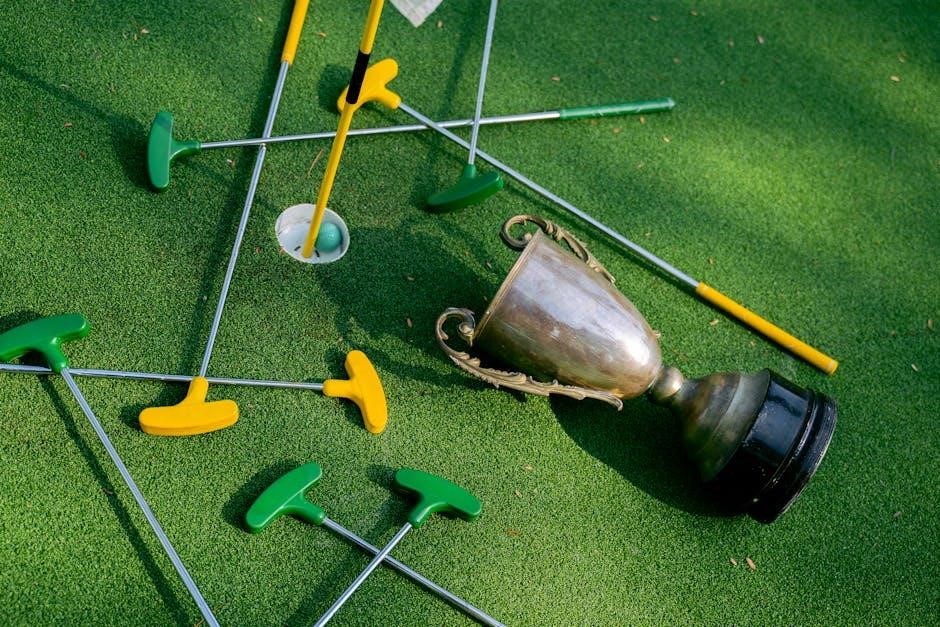
Golf Club Distance Charts: A General Overview
Golf club distance charts provide a standardized reference for estimating how far each club travels, helping players select the right club for precise shot execution and strategy planning.
Understanding Standard Distance Gaps Between Clubs
Standard distance gaps between golf clubs are crucial for consistent play. Typically, irons gap at 10 yards between each club, with fairway woods and drivers offering greater yardage. This structured progression ensures seamless club selection, allowing players to cover varying distances effectively. By understanding these gaps, golfers can better plan their shots and choose the right club for the situation. Proper gapping enhances accuracy and strategic play, helping players avoid overlapping distances and improve overall performance on the course.
How Irons Typically Gap at 10 Yards Between Each Club
Irons are designed with a standard gap of approximately 10 yards between each club. For instance, a 9-iron might travel 150 yards, while an 8-iron could reach 160 yards, and a 7-iron 170 yards. This consistent progression allows golfers to maintain precise control over their shots, ensuring that each club serves a specific range. By understanding this 10-yard gap, players can make accurate club selections and plan their approach shots effectively. This structured distance pattern is fundamental for maintaining consistency and improving scoring in golf.
Driver and Fairway Wood Distances for Maximum Yardage
Drivers and fairway woods are designed to deliver maximum yardage, with drivers typically producing the longest distances. For many golfers, a driver can range from 200 to 300 yards, depending on swing speed and technique. Fairway woods, such as 3-woods and 5-woods, generally fall between 170 to 270 yards, offering a balance of distance and accuracy. These clubs are crucial for tee shots and long approaches, allowing golfers to cover significant ground. Understanding the distance potential of these clubs helps players select the right tool for the situation. By optimizing swing speed and ball striking, golfers can maximize the performance of their drivers and fairway woods, ensuring they achieve the best possible results on the course.
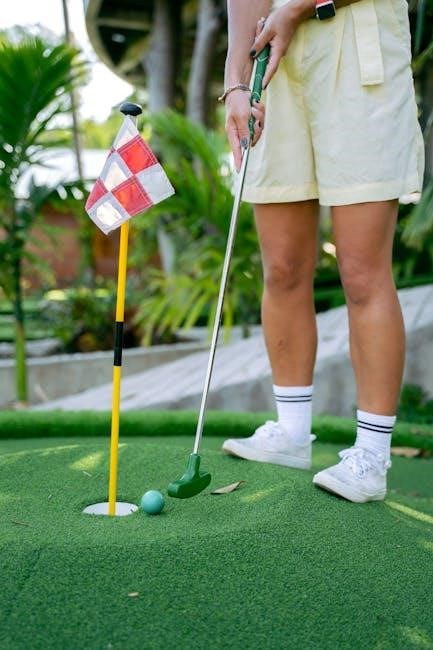
Club-Specific Distance Guides
Understanding each club’s unique distance characteristics is key to improving your game, as swing speed, ball speed, and smash factor vary across drivers, irons, and wedges.
Driver Distances: How to Maximize Your Tee Shots
Maximizing driver distances requires understanding swing speed, ball speed, and smash factor. A faster swing speed generates more ball speed, leading to greater distance. Smash factor, the ratio of ball speed to swing speed, plays a crucial role in efficiency. Using a launch monitor can help track these metrics. Proper club fitting ensures the driver suits your swing characteristics. On-course testing allows you to measure real-world distances. By optimizing these elements, golfers can achieve longer, more consistent tee shots. Regular practice and adjustments are key to maintaining peak performance with your driver.
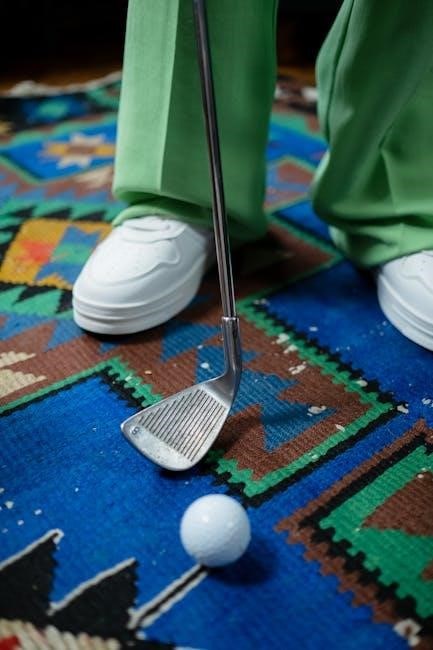
Fairway Woods: Average Distances and When to Use Them
Fairway woods are versatile clubs designed for shots requiring distance and accuracy. Average distances vary, with a 3-wood typically ranging from 180 to 240 yards, depending on swing speed and ball striking quality. These clubs are ideal for tee shots on tight fairways or approach shots from the fairway. Proper gapping between fairway woods ensures consistent yardage coverage. Using a fairway wood off the tee can provide better control than a driver. On-course testing helps determine personal distances, while launch monitors offer precise data. Regular practice with fairway woods enhances consistency, making them a reliable choice for various scenarios on the course.
Hybrids: Bridging the Gap Between Woods and Irons
Hybrids are designed to combine the forgiveness of fairway woods with the control of irons, making them versatile for various shots. They typically fill the distance gap between long irons and fairway woods, offering higher trajectory and softer landing. Average distances for hybrids range from 150 to 220 yards, varying by loft and swing speed. Hybrids are ideal for shots from the rough, long approach shots, or when a higher trajectory is desired. They are easier to hit than long irons, providing more consistency. Testing hybrids on the course and using launch monitors helps determine precise distances. Regular practice with hybrids enhances accuracy and ensures they bridge the gap effectively in your bag.
Irons: A Breakdown of Expected Distances for Each Club
Irons are a cornerstone of a golfer’s bag, with each club designed for specific distances. Typically, irons are gapped in 10-yard increments. A 9-iron might fly 150 yards, while an 8-iron reaches 160, and so on. This consistent spacing helps players choose the right club for each shot. Swing speed and ball striking quality significantly influence iron distances. Higher lofted irons, like wedges, cover shorter distances with higher trajectories. Testing on the course and using technology like launch monitors provide precise measurements. Regular practice and adjustments ensure accuracy. Understanding iron distances is crucial for strategic play, allowing golfers to select the optimal club for every situation, enhancing overall performance and scoring potential.
Wedges: Understanding Loft and Distance Relationships
Wedges are specialized irons with higher lofts, designed for precision and control at shorter distances. Loft directly impacts distance, with higher loft resulting in shorter shots but greater accuracy; Pitching wedges (46-48°) typically fly 120-140 yards, gap wedges (50-52°) around 100-120 yards, sand wedges (54-56°) 80-100 yards, and lob wedges (58-60°) 60-80 yards. Swing speed and ball striking quality influence these distances. Testing on the course and using launch monitors help refine personal yardages. Proper wedge play enhances short-game performance, allowing for better scoring opportunities. Understanding loft and distance relationships is key to selecting the right wedge for each shot, improving overall accuracy and consistency around the greens.
Putters: The Role of Distance Control on the Greens
Putters are essential for precise distance control on the greens, where accuracy is crucial for scoring. Unlike other clubs, putters are designed for low-speed, rolling shots, requiring a consistent strike and pace. The primary factor influencing distance is the speed of the putt, which must account for green slope, grain, and texture. Golfers often use visual alignment and practice to gauge distances effectively; Testing on the course and using tools like launch monitors can help refine personal distance control. Proper pacing and green reading are vital for consistent putting performance, making the putter a key tool for lowering scores and achieving success in the short game.
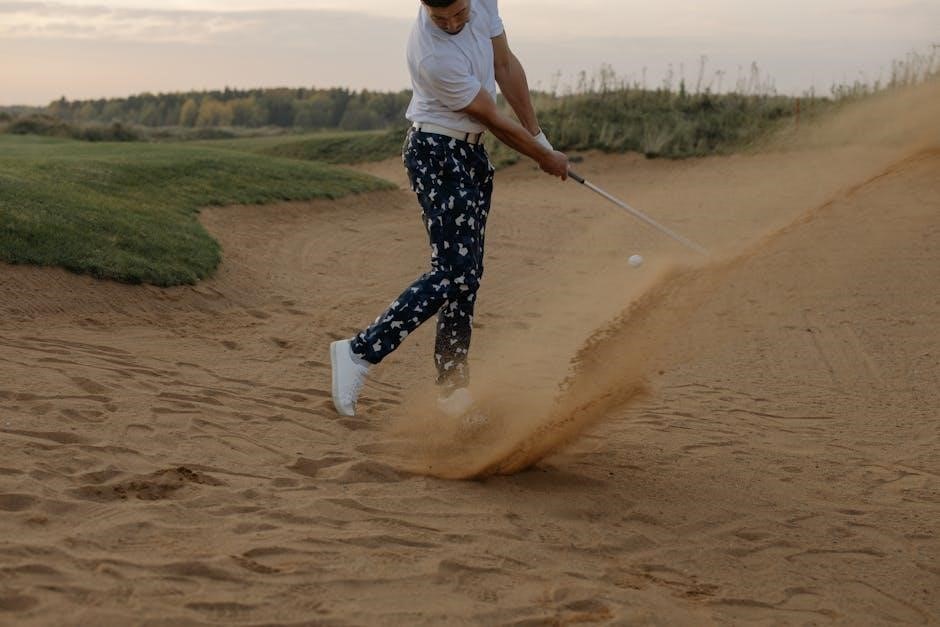
How to Determine Your Personal Golf Club Distances
Calculate your swing speed, ball speed, and smash factor to create a personalized distance chart, ensuring accurate club selection for consistent performance on the course.
On-Course Testing: How to Measure Your Club Distances Accurately
Accurate on-course testing involves hitting multiple shots with each club under controlled conditions to measure carry and total distances. Use a GPS device or rangefinder to record precise yardages. Test on a flat, open space to minimize variables like slope and wind. Track the average distance for each club to account for shot-to-shot variations. Repeat the process under different conditions, such as uphill or downhill lies, to understand how terrain affects your distances. Documenting these results creates a personalized distance chart, enabling better club selection and strategic decision-making during rounds. Consistent testing helps refine your understanding of how environmental factors influence your shots.
Using Launch Monitors and Technology for Precise Distance Tracking
Launch monitors and advanced golf technology provide precise data for tracking club distances. These devices measure key metrics like swing speed, ball speed, and smash factor, offering insights into performance. Sensors and cameras capture data on launch angle, spin rate, and trajectory, helping refine distance accuracy. Portable devices like SkyTrak and FlightScope are popular for on-course use, while apps and software tools offer additional analysis. By integrating this technology, golfers gain a deeper understanding of their swing mechanics and how they influence distance. Regular use of launch monitors helps identify trends and inconsistencies, enabling targeted practice and equipment adjustments for optimal performance.
Creating a Personal Distance Chart for Every Club in Your Bag
A personalized distance chart is essential for consistent play, detailing the average yardage for each club under various conditions. Start by testing each club on the course or range, recording distances repeatedly for accuracy. Note swing speed, ball flight, and environmental factors like wind or terrain. Organize data into a chart, highlighting gaps between clubs to ensure proper gapping strategy. Regular updates are crucial as swing mechanics evolve or new clubs are added; This chart becomes a vital on-course tool, aiding club selection and strategic decision-making. By tailoring it to individual performance, golfers can enhance accuracy and lower scores, ensuring every shot is optimally planned.
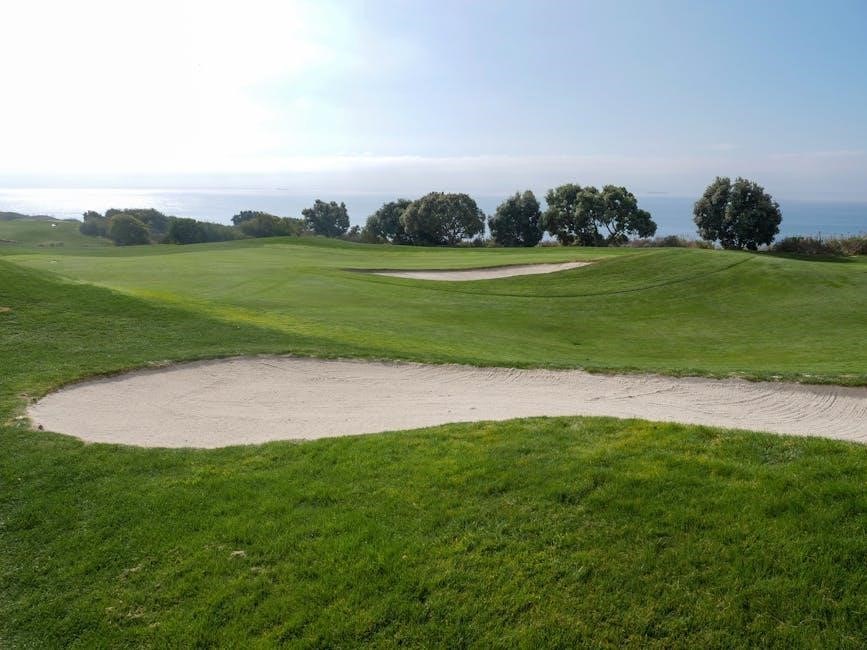
Advanced Strategies for Optimizing Club Distances
Refine your game with tailored club gapping, adjusting for terrain and wind, and leveraging technology for precise distance tracking to maximize accuracy and consistency on the course.
Gapping Strategy: Ensuring Consistent Yardage Between Clubs
A well-planned gapping strategy ensures consistent yardage between clubs, allowing golfers to cover every distance seamlessly. Start by determining the maximum distance of your longest club, then work backward, allocating even gaps. For example, if your driver reaches 250 yards, your 3-wood might be 220, and so on. Irons typically gap at 10 yards each, but this can vary based on swing speed and ball striking. Using launch monitors or on-course testing helps refine these distances. A consistent gapping strategy prevents distance overlaps and ensures each club has a specific role, improving decision-making and shot selection during play.
Adjusting for Terrain, Wind, and Other Environmental Factors
Environmental factors like terrain, wind, and temperature significantly impact golf club distances. Uphill shots require more club, while downhill shots need less. Wind can extend or reduce carry, demanding club adjustments. Higher altitudes increase ball flight, so using less club is essential. Temperature affects ball speed, with colder conditions reducing distance. Rain or wet conditions can also lower ball speed and roll. To adapt, golfers must assess each environmental condition and adjust their club selection accordingly. This ensures accurate distance control and consistent performance, even in challenging weather or terrain. Regular practice in various conditions helps refine these adjustments for better overall play.
Club Fitting: How Proper Equipment Can Enhance Distance Accuracy
Club fitting is crucial for optimizing distance accuracy, as ill-fitting clubs can lead to inconsistent performance. Properly fitted clubs ensure optimal swing mechanics, maximizing ball speed and smash factor. A club with the correct loft, lie, and shaft length aligns with a golfer’s swing, reducing mishits and improving distance control. Custom fittings often involve launch monitors to analyze swing dynamics and recommend precise specifications. This tailored approach helps golfers achieve consistent yardages, bridging gaps between clubs and enhancing overall scoring potential. Regular fittings, especially as swing characteristics change, are essential for maintaining peak performance and distance accuracy on the course.
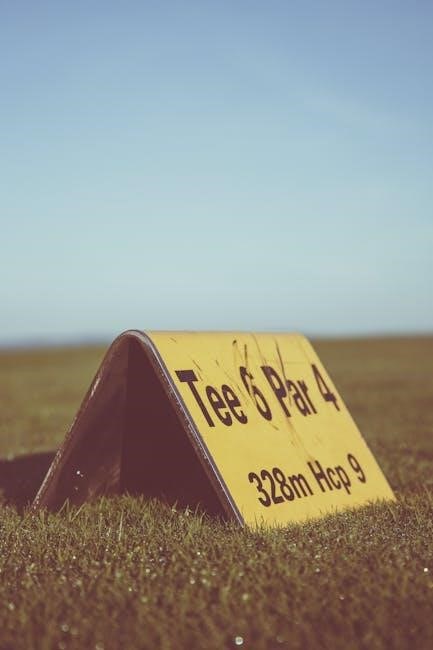
Common Mistakes Golfers Make with Club Distances
Golfers often miscalculate distances by ignoring swing speed variations, misjudging smash factor, and not adjusting for environmental conditions, leading to inconsistent shots and poor scoring opportunities.
Overestimating or Underestimating Swing Speed and Ball Speed
Many golfers inaccurately assess their swing speed and ball speed, leading to poor club selection. Overestimating swing speed results in short shots, while underestimating can cause over-shooting. Ball speed, influenced by factors like swing mechanics and equipment, also plays a crucial role. Miscalibrating these elements disrupts distance control, affecting overall performance. Accurate measurement using tools like launch monitors ensures proper club selection, enabling precise distance management and improved scoring opportunities. Regular practice and adjustments are essential to maintain consistency and avoid these common mistakes that hinder progress on the course.
Ignoring the Importance of Smash Factor for Distance
Smash factor, the ratio of ball speed to swing speed, is often overlooked yet critical for maximizing distance. A higher smash factor indicates efficient energy transfer, resulting in longer shots. Golfers who neglect this metric may fail to optimize their swings, leading to shorter distances. By understanding and improving smash factor through proper technique and equipment, players can achieve greater consistency and better performance. Ignoring this key factor can hinder progress, making it essential to incorporate it into practice routines for enhanced results on the course. Regular analysis and adjustments can help golfers unlock their full potential and improve overall game effectiveness.
Not Accounting for Variable Conditions on the Course
Failing to consider environmental factors like wind, terrain, and weather can significantly impact shot distance. Uphill shots may fall short, while downhill shots can exceed expectations. Wind resistance or assistance alters ball flight, affecting carry distance. Moisture in the air or on the ground can also reduce or increase ball speed. Temperature and elevation changes further complicate distance calculations. Golfers must adapt club choices to these variables, as ignoring them leads to inconsistent and inaccurate shots. Adjusting for course conditions ensures better decision-making and improves overall performance. Recognizing and compensating for these factors is essential for maintaining precision and control in various playing environments.
Mastering golf club distances is key to enhancing your game. Consider swing speed, ball speed, and smash factor to optimize performance. Regular practice and adjustments ensure continuous improvement and precision.
How to Continuously Improve Your Understanding of Club Distances
Improving your understanding of golf club distances requires consistent practice and adaptation. Regularly test your clubs on the course to measure accuracy and adjust for variations in swing speed and ball striking quality. Utilize launch monitors and technology to gain precise data on ball speed, smash factor, and trajectory. Maintain a personalized distance chart to track progress and identify gaps in your game. Adjust club selections based on terrain, wind, and other environmental factors to enhance accuracy. Regularly review and update your strategy to ensure optimal performance. By combining on-course testing with technological insights, you can refine your skills and achieve consistent results.
The Importance of Regular Practice and Adjustment
Regular practice is essential to refine your understanding of club distances, ensuring accuracy and consistency. Dedicate time to test each club under various conditions, tracking how swing speed, ball speed, and smash factor affect performance. Adjustments should be made based on data collected from launch monitors and on-course testing. Environmental factors like terrain and wind also play a role, requiring adaptability. By continuously refining your technique and club selection, you can develop a reliable and precise approach to the game. Regular practice not only improves distance control but also enhances overall performance, helping you make informed decisions on the course for better scoring opportunities.

Additional Resources
Explore recommended tools, apps, and professional guides to enhance your understanding of golf club distances, improving your game with precise tracking and expert tutorials.
Recommended Tools and Apps for Tracking Club Distances
Utilize launch monitors like TrackMan or SkyTrak for precise distance and swing analytics. GPS devices such as Garmin Approach and Bushnell Neo offer real-time yardage measurements. Apps like Golf Buddy, SwingU, and 18Birdies provide personalized distance tracking and stats. Shot-tracking wearables, such as Garmin Approach S60 or ShotZoom, monitor your shots and calculate distances automatically. Additionally, apps like E6 Connect and Foresight Sports simulate on-course conditions for virtual practice. These tools help golfers refine their club distances, optimize performance, and make data-driven decisions on the course. Regular use of these resources ensures consistent improvement and a deeper understanding of your game.
Professional Guides and Tutorials for Maximizing Your Game
Professional guides and tutorials are invaluable for refining your understanding of golf club distances. Resources like IELTS Writing Answer Key and structured golf lessons from renowned coaches offer detailed insights. Video tutorials by instructors such as Butch Harmon and Hank Haney provide actionable tips to improve swing mechanics and ball striking. Interactive drills and practice plans help golfers tailor their approach to specific clubs. Additionally, many guides include exercises to enhance swing speed, smash factor, and consistency. These tools cater to all skill levels, ensuring a personalized path to mastery. By leveraging these resources, golfers can refine their technique, optimize club distances, and achieve better overall performance on the course.